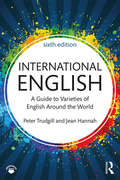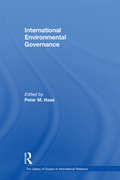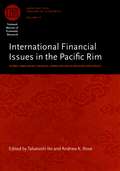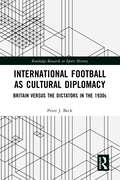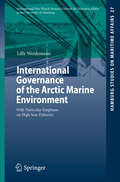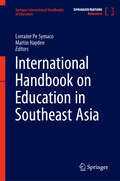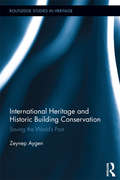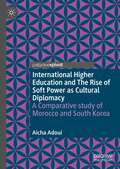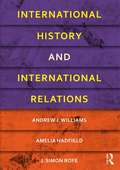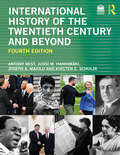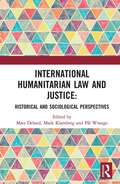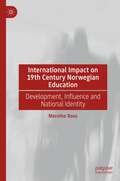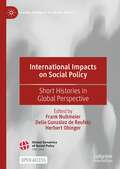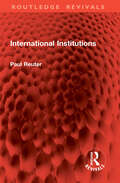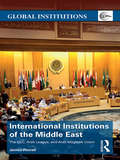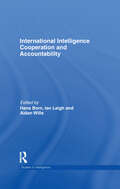- Table View
- List View
International Encyclopedia of Technical Analysis
by Jae K. Shim Joel G. Siegel Anique A. Qureshi Jeffrey BrauchlerInvestors are firmly entrenched in two camps: those who believe that economic and financial fundamentals are the keys to investment success, and those who prefer some form or other of technical analysis. To serve those who use technical analysis, the authors have written a practical, useful, and comprehensive guide to all the major and minor technical analysis systems used by today's investors and financial professionals. In this unique reference book, technical analysis systems are discussed in depth, with detailed attention to the pros and cons of each. In addition, the Encyclopedia offers a mini-dictionary of the terms, concepts, and market issues that are part of the discipline of technical analysis.
International English: A Guide to Varieties of English Around the World
by Peter Trudgill Jean HannahFrom Singapore to Scotland, Canada to the Channel Islands, Namibia to New Zealand and beyond, International English takes you on a fascinating journey through the varieties of English spoken around the world. Comparisons across the varieties provide a comprehensive guide to differences in phonetics, phonology, grammar and vocabulary, making this a useful resource for teachers of English as a foreign language and linguistics students alike. This sixth edition has been thoroughly updated to include the following: new sections on the Death of RP, Estuary English, Multicultural London English, the Dublin accent and Fijian English; updated material on RP phonology, New Zealand English phonology, Australian English lexis, North American English lexis and the Northern Cities Chain Shift; revised and updated references and bibliography. This textbook comes with free-to-download MP3 files at www.routledge.com/9781138233690, which demonstrate the different varieties featured in the book – ideal for use in class, at home or on the move. International English remains a key and indispensable resource for teachers and students, and is essential reading for anyone studying varieties of English in a global context.
International Environmental Governance (The\library Of Essays In International Relations Ser.)
by Peter M. HaasInternational Environmental Governance reviews the contentious approaches to addressing global and transboundary environmental threats. The volume collects together the most influential and important literature on the major political approaches to dealing with these problems, their histories, major debates, and research frontiers. It is accompanied by a substantial introduction which reviews the evolution of the academic contribution to environmental governance, focusing on a wide array of international environmental problems.
International Evidence on Recovery from Recessions
by Valerie Cerra Sweta C. Saxena Ugo PanizzaA report from the International Monetary Fund.
International Express: New Yorkers on the 7 Train
by William Kornblum Stéphane TonnelatNicknamed the International Express, the New York City Transit Authority 7 subway line runs through a highly diverse series of ethnic and immigrant neighborhoods in Queens. People from Andean South America, Central America, China, India, Italy, Korea, Mexico, Pakistan, Poland, Romania, and Vietnam, as well as residents of a number of gentrifying blue-collar and industrial neighborhoods, fill the busy streets around the stations. The 7 train is a microcosm of a specifically urban, New York experience, in which individuals from a variety of cultures and social classes are forced to interact and get along with one another. For newcomers to the city, mastery of life in the subway space is a step toward assimilation into their new home.In International Express, the French ethnographer Stéphane Tonnelat and his collaborator William Kornblum, a native New Yorker, ride the 7 subway line to better understand the intricacies of this phenomenon. They also ask a group of students with immigrant backgrounds to keep diaries of their daily rides on the 7 train. What develops over time, they find, is a set of shared subway competences leading to a practical cosmopolitanism among riders, including immigrants and their children, that changes their personal values and attitudes toward others in small, subtle ways. This growing civility helps newcomers feel at home in an alien city and builds what the authors call a "situational community in transit." Yet riding the subway can be problematic, especially for women and teenagers. Tonnelat and Kornblum pay particular attention to gender and age relations on the 7 train. Their portrait of integrated mass transit, including a discussion of the relationship between urban density and diversity, is invaluable for social scientists and urban planners eager to enhance the cooperative experience of city living for immigrants and ease the process of cultural transition.
International Fascism, 1919-45 (Totalitarianism Movements and Political Religions)
by Robert MallettThe essays that comprise this study of 20th-century fascism shift the focus away from the German and Italian models and towards the influence of fascist ideology within other countries.
International Financial Issues in the Pacific Rim: Global Imbalances, Financial Liberalization, and Exchange Rate Policy
by Takatoshi Ito Andrew K. RoseThe imbalanced, yet mutually beneficial, trading relationship between the United States and Asia has long been one of international finance's most perplexing mysteries. Although the United States continues to post a substantial trade deficit-- and China reaps the benefits of a surplus-- the dollar has yet to sink in the face of ever-increasing account disparities. International Financial Issues in the Pacific Rim explains why the United States enjoys a seemingly symbiotic relationship with its trading partners despite stark inequities in the trade balance, especially with Asia. This timely and well-informed study also debunks the assumed link between economic openness and low inflation in the region, identifies the serious gap between academic and private-sector researchers' understanding of exchange rate volatility, and analyzes the liberalization of Asian capital accounts.International Financial Issues in the Pacific Rim will have broad implications for global trade and economic policy issues in Asia and beyond.
International Flows in the Belt and Road Initiative Context: Business, People, History and Geography (Palgrave Series in Asia and Pacific Studies)
by Hing Kai Chan Faith Ka Shun Chan David O’BrienThis edited volume brings together a wide range of academics to engage with inter-disciplinary research perspectives in response to the development of The Belt and Road Initiative (BRI) which opens unparalleled opportunities to gain access to new markets in Asia, Europe and Africa. The collection examines opportunities offered in key areas such as trade and investment, policy coordination, facilities connectivity and cultural exchange. It also notably considers how the historical, environmental, cultural and political background to the BRI impacts this hugely ambitious plan which has been described as the ‘new Silk Road', as well as the challenges across these spheres in a part of the world which has witnessed much instability historically.
International Football as Cultural Diplomacy: Britain Versus the Dictators in the 1930s (Routledge Research in Sports History)
by Peter J. BeckDrawing on wide-ranging archival research, this authoritative new history examines the cultural diplomatic role played by British football in international affairs, British foreign policy, and international football during the 1930s. For British governments, soccer diplomacy emerged as a favoured instrument of soft power when facing Hitler’s Germany, Mussolini’s Italy, Hirohito’s Japan, and Stalin’s Russia on and off the field. Examining the evolving relationship between successive governments and the Football Association, this book records how governments, though publicly espousing the distinctive autonomy of British sport, pursued privately a progressively interventionist role regarding international matches played by England and Football League clubs. Embedding its central themes in the wider context of international relations, the war of ideas between the liberal democracies and the dictatorships, and international football, the book also interrogates one of the most shocking moments in British sporting history, when England players gave Nazi salutes in Berlin in 1938, an episode in which virtue signalling was used in support of footballing appeasement. Offering readers an informed historical perspective on some of the modern world’s most significant issues, from the divide between dictatorships and liberal democracies to the use of sport as cultural diplomacy aka cultural propaganda, this book is fascinating reading for anybody with an interest in the history of Britain, sport history, football, international politics, diplomacy or international institutions.
International Governance of the Arctic Marine Environment
by Lilly WeidemannThe Arctic is particularly affected by climate change; over the past few decades, temperatures in this area have risen twice as fast as the mean global rate. The most prominent effect of global climate change in the region is the melting sea ice in the Arctic Ocean, which enables a multitude of ocean uses to be initiated and extended, such as shipping, fishing and oil and gas extraction. Unlike in the Antarctic, there is currently no single comprehensive legal regime for governance of the Arctic. Instead, the region is regulated by a patchwork of international treaties, above all the United Nations Convention on the Law of the Sea (UNCLOS), various regional and sub-regional agreements, national laws and soft-law agreements. This treatise provides an evaluation of the governance regime that regulates the use of the Arctic marine environment and its readiness to protect these fragile ecosystems in light of the consequences of climate change.
International Handbook of Research in History, Philosophy and Science Teaching
by Michael R. MatthewsThis inaugural handbook documents the distinctive research field that utilizes history and philosophy in investigation of theoretical, curricular and pedagogical issues in the teaching of science and mathematics. It is contributed to by 130 researchers from 30 countries; it provides a logically structured, fully referenced guide to the ways in which science and mathematics education is, informed by the history and philosophy of these disciplines, as well as by the philosophy of education more generally. The first handbook to cover the field, it lays down a much-needed marker of progress to date and provides a platform for informed and coherent future analysis and research of the subject. The publication comes at a time of heightened worldwide concern over the standard of science and mathematics education, attended by fierce debate over how best to reform curricula and enliven student engagement in the subjects. There is a growing recognition among educators and policy makers that the learning of science must dovetail with learning about science; this handbook is uniquely positioned as a locus for the discussion. The handbook features sections on pedagogical, theoretical, national, and biographical research, setting the literature of each tradition in its historical context. It reminds readers at a crucial juncture that there has been a long and rich tradition of historical and philosophical engagements with science and mathematics teaching, and that lessons can be learnt from these engagements for the resolution of current theoretical, curricular and pedagogical questions that face teachers and administrators. Science educators will be grateful for this unique, encyclopaedic handbook, Gerald Holton, Physics Department, Harvard University This handbook gathers the fruits of over thirty years' research by a growing international and cosmopolitan community Fabio Bevilacqua, Physics Department, University of Pavia
International Handbook on Education in Southeast Asia (Springer International Handbooks of Education)
by Martin Hayden Lorraine Pe SymacoThis International Handbook provides a detailed account of the education systems of 11 Southeast Asian nations, including Brunei Darussalam, Cambodia, Indonesia, Lao People’s Democratic Republic, Malaysia, Myanmar, the Philippines, Singapore, Thailand, Timor- Leste, and Vietnam. It presents a systematic sector-by-sector explanation of how these national education systems deliver educational services and respond to national and international issues and challenges. With 56 chapters, the International Handbook is the region’s most comprehensive educational reference source. In the first of its chapters, the editors introduce the regional context and draw attention to the distinctive characteristics of each of the 11 systems. Southeast Asia, representing 8.5% of the world’s population, is as dynamic as it is diverse. The International Handbook charts progress and establishes a benchmark for documenting future developments. It also provides a stepping-off point for more detailed investigations of decision-making processes and outcomes across the 11 national education systems.
International Heritage and Historic Building Conservation: Saving the World’s Past
by Zeynep AygenThe majority of books in English on historic building conservation and heritage preservation training are often restricted to Western architecture and its origins. Consequently, the history of building conservation, the study of contemporary paradigms and case studies in most universities and within wider interest circles, predominantly in the UK, Europe, and USA focus mainly on Europe and sometimes the USA, although the latter is often excluded from European publications. With an increasingly multicultural student body in Euro-American universities and with a rising global interest in heritage preservation, there is an urgent need for publications to cover a larger geographical and social area including not only Asia, Australia, Africa and South America but also previously neglected countries in Europe like the new members of the European Community and the northern neighbour of the USA, Canada. The inclusion of the ‘other’ in built environment education in general and in building conservation in particular is a pre-requisite of cultural interaction and widening participation. International Heritage and Historic Building Conservation assesses successful contemporary conservation paradigms from around the world. The book evaluates conservation case studies from previously excluded areas of the world to create an integrated account of Historic Building Conservation that crosses the boundaries of language and culture and sets an example for further inclusive research. Analyzing the influence of financial constraints, regional conflicts, and cultural differences on the heritage of disadvantaged countries, this leading-edge volume is essential for researchers and students of heritage studies interested in understanding their topics in a wider framework.
International Higher Education and The Rise of Soft Power as Cultural Diplomacy: A Comparative study of Morocco and South Korea
by Aicha AdouiThis book offers a comprehensive analysis of international higher education and soft power as cultural diplomacy, through a study of Morocco and South Korea. It draws on extensive original research to explore the social, political, and economic factors that have shaped the international standing of both countries in terms of higher education. The research reveals the importance of higher education in promoting soft power and the role of international universities in enhancing the international reputation of a country. The book's key findings demonstrate the impact of soft power as cultural diplomacy on international relations and the contribution it makes to research in the field of international higher education.
International History and International Relations
by J. Simon Rofe Andrew J. Williams Amelia HadfieldThis innovative new textbook seeks to provide undergraduate students of international relations with valuable and relevant historical context, bridging the gap and offering a genuinely interdisciplinary approach. Each chapter integrates both historical analysis and literature and applies this to an international relations context in an accessible fashion, allowing students to understand the historical context in which these core issues have developed. The book is organised thematically around the key issues in international relations such as war, peace, sovereignty, identity, empire and international organisations. Each chapter provides an overview of the main historical context, theories and literature in each area and applies this to the study of international relations. Providing a fresh approach, this work will be essential reading for all students of international relations and international relations theory.
International History of the Twentieth Century and Beyond
by Joseph A. Maiolo Kirsten E. Schulze Antony Best Jussi HanhimakiThis hugely successful global history of the twentieth century is written by four prominent international historians for first-year undergraduate level and upward. Using their thematic and regional expertise, the authors have produced an authoritative yet accessible and seamless account of the history of international relations in the last century, covering events in Europe, Asia, the Middle East, Africa and the Americas. They focus on the history of relations between states and on the broad ideological, economic and cultural forces that have influenced the evolution of international politics over the past one hundred years. The third edition is thoroughly updated throughout to take account of the most recent research and global developments, and includes a new chapter on the international history of human rights and its advocacy organizations, including NGOs. Additional new features include: New material on the Arab Spring, including specific focus on Libya and Syria Increased debate on the question of US decline and the rise of China. A timeline to give increased context to those studying the topic for the first time. A fully revised companion website including links to further resources and self-testing material can be found at www.routledge.com/cw/best Antony Best is Associate Professor in International History at the London School of Economics. Jussi M. Hanhimäki is Professor of International History and Politics at the Graduate Institute of International Studies, Geneva. Joseph A. Maiolo is Professor of International History at the Department of War Studies, Kings College London. Kirsten E. Schulze is Associate Professor in International History at the London School of Economics.
International History of the Twentieth Century and Beyond
by Jussi M. Hanhimäki Joseph A. Maiolo Kirsten E. Schulze Antony BestNow in its fourth edition, this highly successful global history of the twentieth century is written by four prominent international historians for first-year undergraduate level and upward.Using their thematic and regional expertise, the authors have produced an authoritative yet accessible and seamless account of the history of international relations in the last century, covering events in Europe, Asia, the Middle East, Africa and the Americas. They focus on the history of relations between states and on the broad ideological, economic and cultural forces that have influenced the evolution of international politics over the last 120 years. The fourth edition is thoroughly updated to take account of the most recent research and global developments, including new material on the impact of the Trump administration on international politics, the rise of China under the leadership of Xi Jinping and the origins of the wars in Ukraine and Gaza.The book is supported by a fully revised companion website including links to further resources and self-testing material, which can be found at www.routledgelearning.com/internationalhistory20c.
International Human Rights: A Comprehensive Introduction
by Michael HaasThis book provides a comprehensive introduction to international human rights -- international human rights law, why international human rights have increasingly risen to world prominence, what is being done about violations of human rights, and what might be done to further promote the cause of international human rights so that everyone may one day have their rights respected regardless of who they are or where they live. It explains: how the concept of international human rights has developed over time the variety of types of human rights (civil-political rights, economic-social rights, as well as a delineation of war crimes) empirical findings from statistical research on human rights institutional efforts to promote human rights an extensive listing of international human rights agreements identification of recent prosecutions of war criminals in domestic and international tribunals ongoing efforts to promote human rights through international aid programs the newest dimensions in the field of human rights (gay rights, animal rights, environmental rights). Richly illustrated throughout with case studies, controversies, court cases, think points, historical examples, biographical statements, and suggestions for further reading, International Human Rights is the ideal introduction for all students of human rights. The book will also be useful for human rights activists to learn how and where to file human rights complaints in order to bring violators to justice. The new edition is fully updated and includes new material on: the Obama presidency the Arab Spring and its aftermath the workings of the International Criminal Court quantitative analyses of human rights war crimes.
International Humanitarian Law and Justice: Historical and Sociological Perspectives
by Mats Deland Mark Klamberg Pål WrangeIn the last decade, there has been a turn to history in international humanitarian law and its accompanying fields. To examine this historization and to expand the current scope of scholarship, this book brings together scholars from various fields, including law, history, sociology, and international relations. Human rights law, international criminal law, and the law on the use of force are all explored across the text’s four main themes: historiographies of selected fields of international law; evolution of specific international humanitarian law rules in the context of legal gaps and fault lines; emotions as a factor in international law; and how actors can influence history. This work will enhance and broaden readers’ knowledge of the field and serve as an excellent starting point for further research.
International Impact on 19th Century Norwegian Education: Development, Influence and National Identity
by Merethe RoosThis book examines Norwegian education throughout the course of the 19th century, and discusses its development in light of broader transnational impulses. The nineteenth century is regarded as a period of increasing national consciousness in Norway, pointing forward to the political independency that the country was granted in 1905. Education played an important role in this process of nationalisation: the author posits that transnational – for the most part Scandinavian – impulses were more decisive for the development of Norwegian education than has been acknowledged in previous research. Drawing on the work of educator and school bureaucrat Hartvig Nissen, who is recognised as the most important educational strategist in 19th century Norway, this book will be of interest to scholars of the history of education and Norwegian education more generally.
International Impacts on Social Policy: Short Histories in Global Perspective (Global Dynamics of Social Policy)
by Herbert Obinger Frank Nullmeier Delia González de ReufelsThis open access book consists of 39 short essays that exemplify how interactions between inter- and trans-national interdependencies and domestic factors have shaped the dynamics of social policy in various parts of the world at different points in time. Each chapter highlights a specific type of interdependence which has been identified to provide us with a nuanced understanding of specific social policy developments at discrete points in history. The volume is divided into four parts that are concerned with a particular type of cross-border interrelation. The four parts examine the impact on social policy of trade relations and economic crises, violence, international organisations and cross-border communication and migration. This book will be of interest to academics and postgraduate students in the field of social policy, global history and welfare state research from diverse disciplines: sociology, political science, history, law and economics.
International Institutions (Routledge Revivals)
by Paul ReuterOriginally published in 1958, this book assesses the continuity and variety of international societies as they have existed in recent history. Although the study of international institutions is firmly based on a foundation of law, this book also encompasses sociology, history and politics. The introduction defines the elements of international society in terms of the accepted principles of group psychology. Part 1 considers the origins of 20th Century international institutions. This historical analysis runs from the ancient civilizations through to the greatly changed relations which followed World War II. The general notions and sources of international law are then examined. Part 2 deals with the structure of day-to-day relations between States and the means of recognizing changes within a State. The United Nations and principal regional organizations are also examined.
International Institutions of the Middle East: The GCC, Arab League, and Arab Maghreb Union (Global Institutions)
by James WorrallThis volume is a key text for understanding the major regional international organizations of the Middle East. Analysing the Arab League, the Gulf Cooperation Council, and the Arab-Maghreb Union in a concise and accessible format, it explores their successes and failures across their full range of activities (economic, social, and political), while contextualising the reasons why many consider that these organizations have stalled.The book:- assesses the reasons why IOs in the Middle East are under-developed relative to neighbouring regional organizations;- explores their history, evolution, and structure, while considering the successes and failures of each IO;- analyses the reasons for the specific difficulties faced by each organization through the context of intra-regional relations;- develops a new framework for analysing the forces that have shaped these bodies and challenges the existing narrative that largely ignores the achievements and prospects of the organizations;- considers the likely impact of the Arab Spring upon the future development of these frequently overlooked regional international organizations.This book will be of great interest to students and scholars of Middle East studies, international organizations, and global governance, as well as diplomats and policymakers
International Integration, Market Structure and Prices (Routledge Revivals)
by Yves BourdetOriginally published in 1988, this study focusses on international economic integration in relation to the passenger car industry and market in the West-European car-making countries, Germany, France, Italy, Sweden and the UK in the second half of the 20th Century when the revival of protectionism was a key feature of the international trading system. The book illustrates the interaction between international integration, market structure and firm conduct and the political sphere at the national as well as the supranational level. Unlike previous analyses of international integration, this book concentrates on a single industry over a significant period.
International Intelligence Cooperation and Accountability (Studies in Intelligence)
by Hans BornThis book examines how international intelligence cooperation has come to prominence post-9/11 and introduces the main accountability, legal and human rights challenges that it poses. Since the end of the Cold War, the threats that intelligence services are tasked with confronting have become increasingly transnational in nature – organised crime, the proliferation of weapons of mass destruction and terrorism. The growth of these threats has impelled intelligence services to cooperate with contemporaries in other states to meet these challenges. While cooperation between certain Western states in some areas of intelligence operations (such as signals intelligence) is longstanding, since 9/11 there has been an exponential increase in both their scope and scale. This edited volume explores not only the challenges to accountability presented by international intelligence cooperation but also possible solutions for strengthening accountability for activities that are likely to remain fundamental to the work of intelligence services. The book will be of much interest to students of intelligence studies, security studies, international law, global governance and IR in general.

